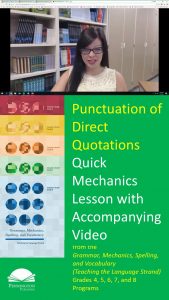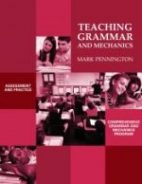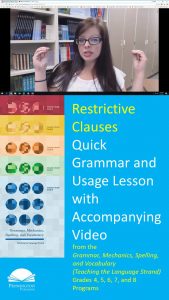Pronoun Number and Person Shifts
Pronoun Number and Person Shifts
Play the quick video lesson HERE and click the upper left back arrow to return to this lesson.
Common Core Language Standard 1
Writers often confuse their readers by changing the number of pronouns. In other words the writers confuse singular and plural forms. Additionally, writers frequently make the mistake of changing the person. In other words the writers change first person, second person, or third person pronouns within the same paragraphs.
Today’s grammar and usage lesson is on vague pronoun references. Remember that a pronoun takes the place of a noun and identifies its antecedent. An antecedent is the noun or pronoun that the pronoun refers to or re-names.
Now let’s read the grammar and usage lesson and study the examples.
A personal pronoun must match singular pronouns to singular nouns or pronouns and plural pronouns to plural nouns or pronouns. Example: Julie has their her own style.
Often number errors are made with gender-specific pronouns. Revise by making the antecedent nouns plural. Example: The student students ate their lunch lunches.Or revise the sentence without the pronouns. Example: The student ate their lunch.
A personal pronoun must also be in the same person as its antecedent. Pronouns are in the first, second, or third person. Revise pronoun person problems by matching the pronoun person to its antecedent. Example: Julie has your her own style.
Now circle or highlight what is right and revise what is wrong according to grammar and usage lesson.
Practice: Tommy and Ashley like his or her school a lot. Both say you have to try their best.
Let’s check the Practice Answers.
Grammar and Usage Practice Answers:
Tommy and Ashley like their school a lot. Both say you have to try your best.
or
Tommy and Ashley like their school a lot. Both say they have to try their best.
Now let’s apply what we have learned.
Writing Application: Write your own sentence using a pronoun antecedent which correctly matches the number of its antecedent.
*****

Pennington Publishing Grammar Programs
Teaching Grammar, Usage, and Mechanics (Grades 4, 5, 6, 7, 8, and High School) are full-year, traditional, grade-level grammar, usage, and mechanics programs with plenty of remedial practice to help students catch up while they keep up with grade-level standards. Twice-per-week, 30-minute, no prep lessons in print or interactive Google slides with a fun secret agent theme. Simple sentence diagrams, mentor texts, video lessons, sentence dictations. Plenty of practice in the writing context. Includes biweekly tests and a final exam.
Grammar, Usage, and Mechanics Interactive Notebook (Grades 4‒8) is a full-year, no prep interactive notebook without all the mess. Twice-per-week, 30-minute, no prep grammar, usage, and mechanics lessons, formatted in Cornell Notes with cartoon response, writing application, 3D graphic organizers (easy cut and paste foldables), and great resource links. No need to create a teacher INB for student make-up work—it’s done for you! Plus, get remedial worksheets, biweekly tests, and a final exam.
Syntax in Reading and Writing is a function-based, sentence level syntax program, designed to build reading comprehension and increase writing sophistication. The 18 parts of speech, phrases, and clauses lessons are each leveled from basic (elementary) to advanced (middle and high school) and feature 5 lesson components (10–15 minutes each): 1. Learn It! 2. Identify It! 3. Explain It! (analysis of challenging sentences) 4. Revise It! (kernel sentences, sentence expansion, syntactic manipulation) 5. Create It! (Short writing application with the syntactic focus in different genre).
Get the Diagnostic Grammar, Usage, and Mechanics Assessments, Matrix, and Final Exam FREE Resource:
![]()







